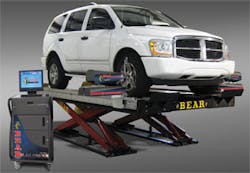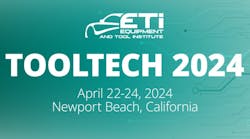Wheel alignment is all about accuracy.
Years ago, achieving that accuracy fell on the shoulders of a well-trained technician. Today, while these techs still need to be well-versed and sharp-sighted, technology advancements in many alignment systems are helping shoulder the load.
Within the past year, the alignment industry has been adding and fine-tuning features such as robotics, vehicle-specific software and hi-definition camera targets to their product lines.
And all of these features serve one purpose—to keep alignment service smooth.
ACCURACY, AUTOMATION AND SUCCESS
“Alignment is a segment that bases its technology on accuracy,” said Oscar Ferreyra, vice president at Cartek Group. “Accuracy, speed and repeatability; those are the three basic components of a successful alignment job.”
When equipment utilizes robotics, it helps ensure seamless accuracy and limits the mundane activities techs must complete during the service.
According to Ferreyra, robotics is “a proven technology coming to this industry, to this segment of products. Up to this point, robotic technology in wheel alignment has only been … by vehicle manufacturers.”
Ferreyra said robotic technology is now available at the shop level at an affordable price.
The high-volume, high-accuracy products based on robots “perform measurement routines automatically and on their own, without the need of clamps that get attached to the rims, and without the need for an operator to attach any sensors or clamps, eliminating human error while saving time,” said Ferreyra.
SAVING FOOTWORK
Often, simplification starts with changes made to the processes leading up to the service itself.
“What we’ve done is added a number of enhancements over the years to take away some of the manual operations that the tech had to do, and to automate them,” said Pete Liebetreu, product manager of Hunter Engineering.
One new feature locks and unlocks vehicle lift slip plates so that when a tech makes adjustments, everything moves freely.
“We’ve made those operate with the touch of a button, and they allow free movement at the appropriate times during the process,” said Liebetreu. “So we’ve actually taken a step that the tech has to remember, and it’s not an easy step to do, and made it automatic. And it happens without the tech’s direct intervention; it happens at the right point in the procedure.”
In addition, before doing alignment services, it’s good practice to inflate the tires to the appropriate pressure to avoid setting the vehicle incorrectly.
The automated component that aids in this process consists of four hoses connected to each wheel position on the lift, “and when you connect those hoses it automatically … starts to fill one or all four tires to the appropriate pressure,” said Liebetreu.
Techs can
even store before and after measurements and give a printout to their customers.
“All of these things are documented,” said Liebetreu, “which is important
for many shop owners because they can show they did responsible work on the vehicles.”
SMART SOFTWARE AND COMMUNICATION
Hardware functions like the ones mentioned above can make the job go much faster. Improved software has also made significant improvements in alignment service.
High-definition cameras, software and console-to-console communication are a few of these additions.
“We’ve introduced a new camera sensor that uses a high-definition target, which means quicker target acquisition,” said Denny Bowen, division product manager of Hunter Engineering. “It really makes a big difference when the technician’s making adjustments because it’s much easier and smaller to work around.”
And automated alignment console and alignment rack console communication helps eliminate unnecessary trips around the car, so that “typical procedures and functions are performed automatically during the course of alignment,” said Bowen.
Some alignment software features offer adjustments and measurements above and beyond typical passenger alignment, and cater to vehicles that “have modified suspension or special wheel and tire packages,” a recent trend that Bowen said is “more expensive and more difficult to service.”
Improved database features also meet very specific needs.
“For years we’ve been accumulating a database that has all the information required to properly align the vehicle, and not just caster, camber and tow specs,” said Bowen. “We measure and photograph every new model [in the database], including control arms, and whether aftermarket correction kits are available. This information is specific to the vehicle being aligned.
“This knowledge allows us to design procedures and software tools that take the tech step-by-step through the alignment,” said Bowen.
All of these features are not just stand-alone features, but can be if a shop owner desires.
Whether a customer chooses to upgrade or buy new with a number of features, he is sure to reap the rewards of a faster, more streamlined process.
“He [the technician] had to carry a hose around to inflate the pressures; he was doing one at a time with the gauge,” said Liebetreu. “That’s now kind of gone by the wayside. Walking around the rack to pull and replace pins has gone by the wayside.
“We’re really trying to get the technician down to making the adjustment portion of the tests … we’re trying to make it as seamless and error-proof as possible.”
WHAT LEARNING CURVE?
Because this equipment is all about simplification, training for the machines themselves is fairly straightforward. Most companies have training reps who will install the equipment and train techs onsite. In many cases, there is also video training onboard the aligner for quick reference.
“[This equipment] usually gives [technicians] a sense of relief,” said Liebetreu. “He doesn’t have to worry about dragging a hose around the car and looking for a tire gauge that may or may not be accurate.
“You’re still doing the same sequences; you’ve just dropped one out.” Liebetreu likens the addition of automated features to adding power windows on a car.
Alignment equipment is similar in that the price range of the equipment generally depends on the level of automation and training features.
“If a tech purchases [one model over another], he has access to most of the adjustment features we discussed, but there is no communication between the alignment console and rack console,” said Bowen. “The tech can go release the slip plates with the touch of a button, but he does have to touch the button. With the higher line equipment, everything is automatic.
“And of course, we still offer the equipment that doesn’t have any buttons to touch at all … you have to do it all manually.”
Where lower line equipment still uses a larger target for the camera, without the high definition, this equipment will still have “all the benefits of camera technology, image-based alignment,” said Bowen.
Whether a shop is looking to buy new, or better educate itself to update older equipment, the alignment industry will certainly comply.
With a minimum life cycle of anywhere from eight to 10 years, according to Ferreyra, many alignment companies “continue to service machines that have been in the market for years, [and] therefore continue to provide updates and parts to those machines as well, so they can remain active and profitable for their owners.”
Ferreyra said that this equipment typically sees a significant return on investment, paying for itself in 24 to 36 months in high-volume shops.
Today with alignment equipment, technicians can choose among many high-tech features. So, aside from having a slow day, why would anyone still choose to take a long walk around a troubled car?


